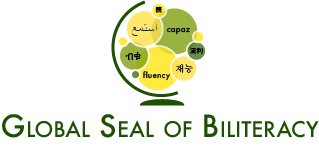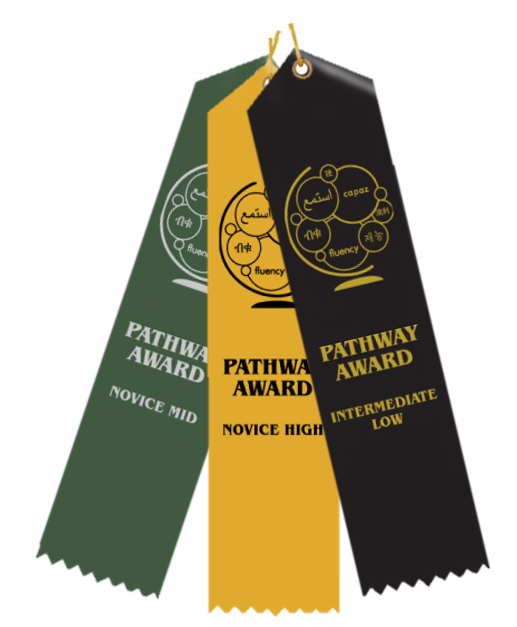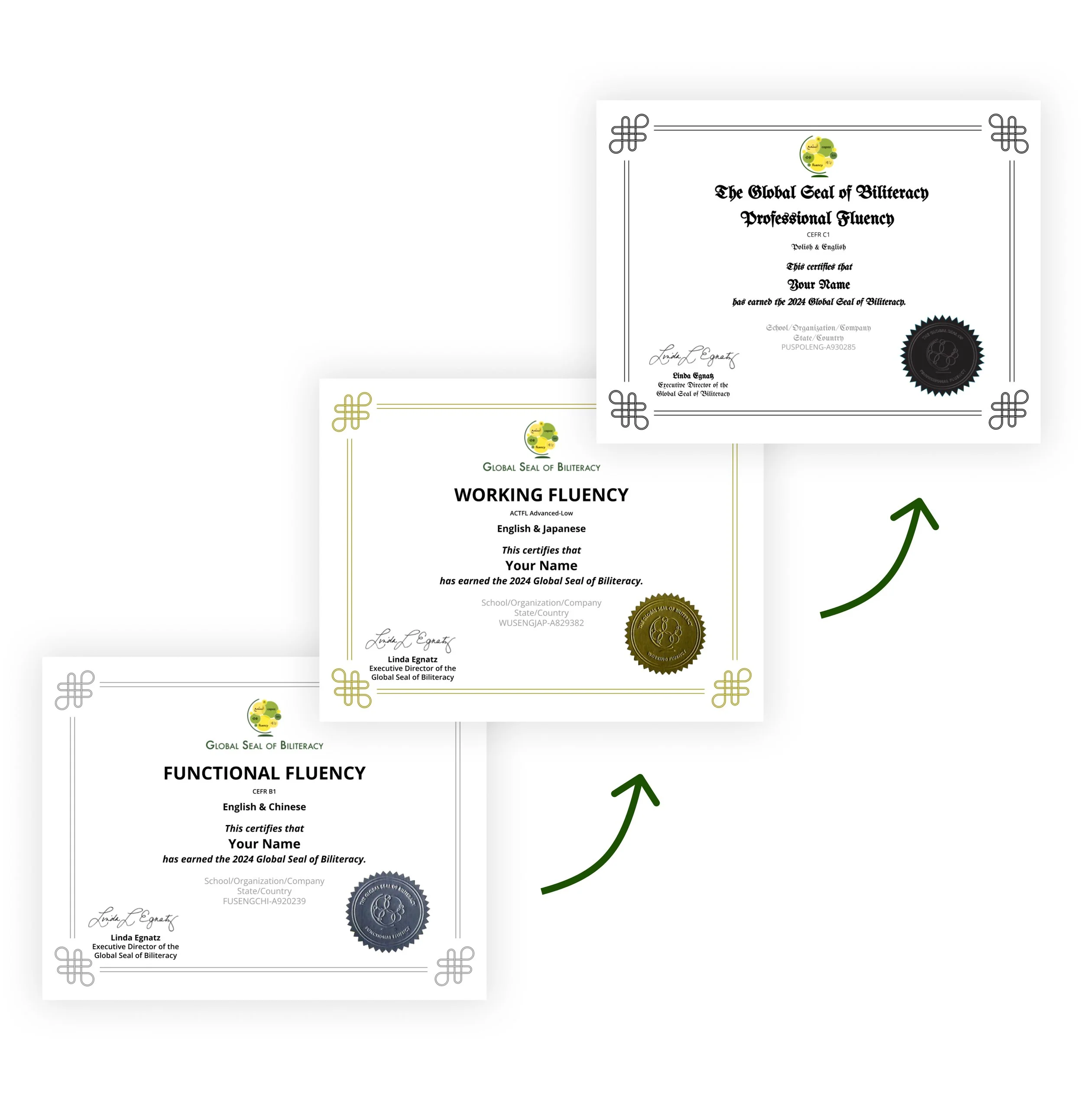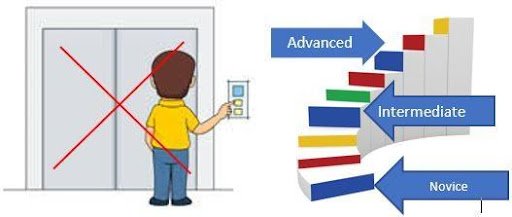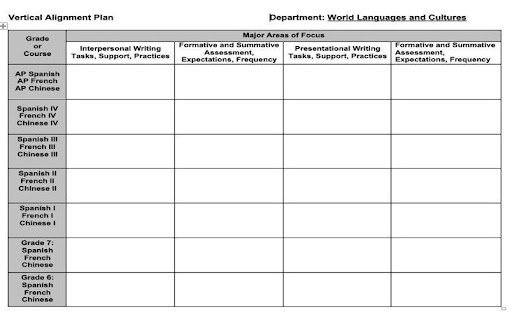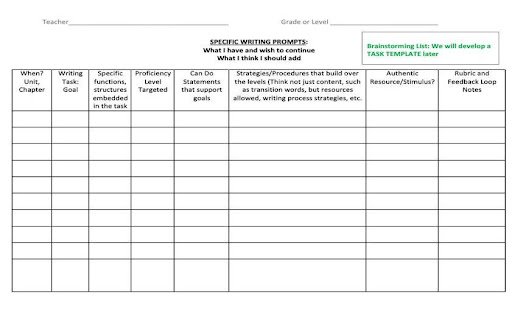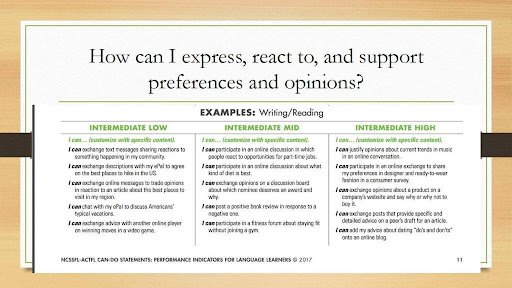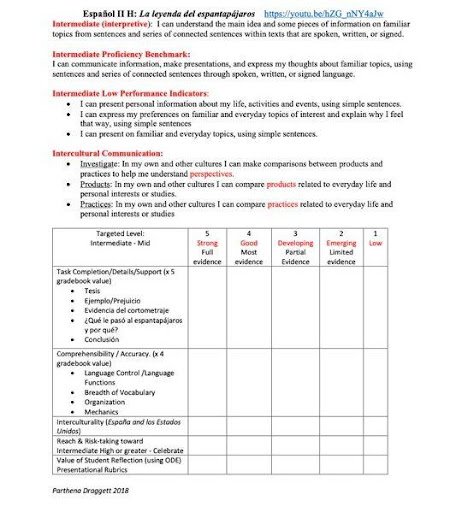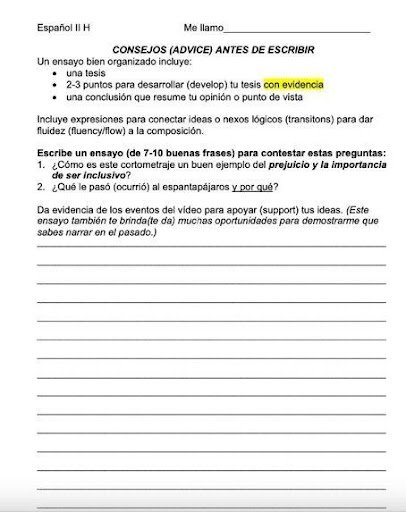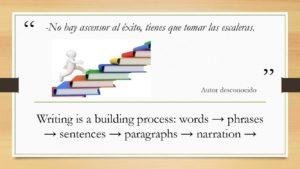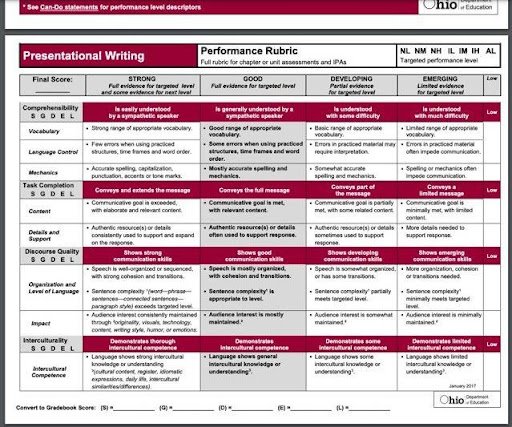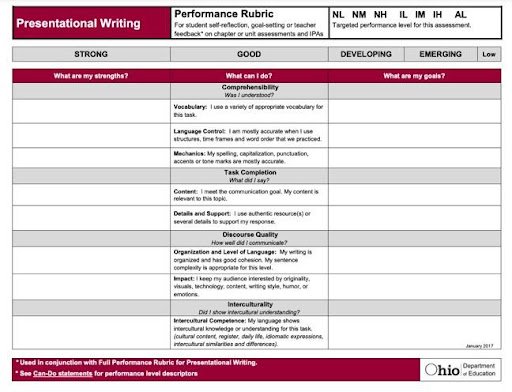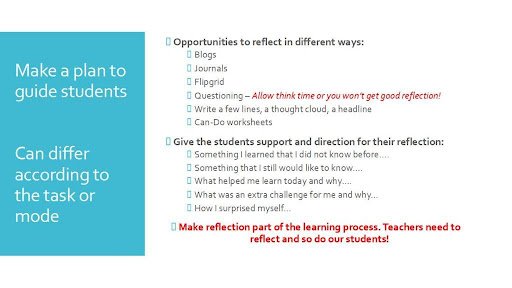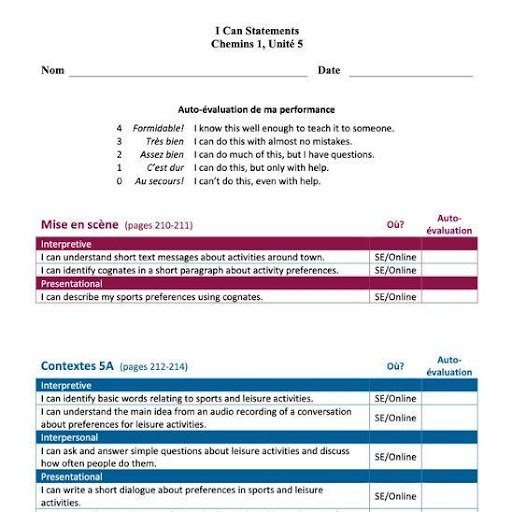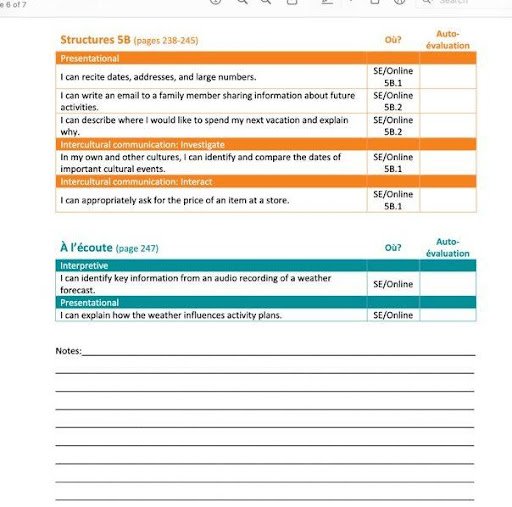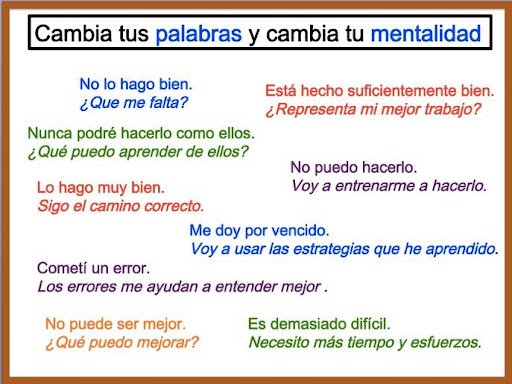In today’s interconnected world, language is more than a subject, it’s a superpower. For Dual Language Immersion (DLI) and primary language programs, the challenge isn’t just teaching vocabulary or grammar. It’s about sustaining motivation, measuring meaningful growth, and celebrating student achievement at every step.
That’s where the Global Seal of Biliteracy and its Pathway Award Ribbons come in. These recognitions turn invisible progress into visible pride, validating students’ ability to communicate in more than one language. They empower learners to see themselves as multilingual, confident, and capable, even in elementary school.
The GLOBE Academy offers a powerful model for how K-8 primary programs can celebrate language proficiency, foster motivation, and build global-ready learners through the Global Seal of Biliteracy. Serving more than 1,200 students across grades K–8, The GLOBE Academy in Atlanta, Georgia, stands out with their languages daily-half of their instruction in English, the other half entirely in their target language.
Inside The GLOBE Academy: Where Language Learning Begins Early
At The GLOBE Academy, students embark on a 50/50 one-way immersion model in French, Spanish, and Mandarin Chinese through 8th grade. From the first day of kindergarten, students are immersed in two languages. Their results speak for themselves:
63% of 8th-grade students earned the Global Seal of Biliteracy in 2025.
92% of 8th graders taking the Advanced Placement (AP) Exam passed the exam and qualified for the Global Seal.
“We’re one of only three schools in the nation where 8th-graders take the AP Language exam,” the school shared. “The Global Seal helps us celebrate what our students can do with their language before they even leave middle school.”
That’s a remarkable accomplishment, and a testament to the school’s belief that language proficiency is achievable, measurable, and worth celebrating at every age.
Why the Global Seal of Biliteracy?
For GLOBE, adopting the Global Seal was initially a practical solution that soon became a powerful motivator.
“Initially, the Global Seal was a way to recognize our 8th-graders for their progress, since our program ends in middle school,” one language leader explained. “But as students began to see it as a goal to work toward, it became a real motivator for increasing proficiency.”
The Global Seal soon became more than a recognition, it became a goalpost that shaped the culture of learning across grades. Students began to track their personal proficiency growth, talk about the Seal as a milestone, and strive more intentionally toward higher performance levels. “Having that tangible credential helped our students set real goals,” the school team shared. “Earning the Global Seal gives them a sense of pride and purpose that carries momentum into high school.”
Why a Biliteracy Credential Matters Before High School
Awarding a biliteracy credential prior to high school provides a data-driven foundation for program alignment and student success. It encourages vertical articulation by clearly identifying proficiency outcomes at the elementary and middle school levels. This documentation not only facilitates accurate placement into secondary programs but also motivates students to remain engaged in language study as they see measurable progress toward advanced proficiency.
For DLI and primary programs, this credential bridges early learning and secondary education. It reinforces the message that language is not just something students study; it’s something they use.
While The GLOBE Academy opts to recognize all students equally at graduation—honoring the collective success of their cohort rather than spotlighting individuals—many other DLI and primary programs are finding creative ways to use Global Seal Pathway Award Ribbons to celebrate progress along the way.
The Pathway Awards offer tiered milestones that correspond to specific proficiency levels. These milestones can:
Provide short-term motivational boosts in the elementary grades.
Help parents visualize their child’s bilingual growth year over year.
Encourage teachers to set class-wide goals and celebrate incremental achievement.
Create a sense of momentum leading to the full Global Seal by the end of middle or high school.
Whether schools choose to recognize every level or focus on the final Seal, the message remains the same: every step toward biliteracy deserves to be celebrated.
Implementation: Collaboration, Timing, and Celebration
Launching a new recognition program can feel intimidating, but GLOBE’s story shows how smooth the process can be with the right partner.
“It’s always been a pleasure and very easy to work with the team at the Global Seal of Biliteracy,” staff shared. “Our biggest challenge was timing; our assessments happen in late March or early April, but every year, we receive our seals in time for our 8th-grade graduation ceremony.”
That ceremony has now become one of the most anticipated events of the school year. As students cross the stage, they’re not just middle school graduates — they’re certified bilingual communicators with a credential that follows them into high school, college, and beyond.
“Students absolutely LOVE gaining the Seal,” teachers shared. “For many, it’s one of the most meaningful parts of their studies here.”
From Kindergarten to Confidence: Building a Culture of Proficiency
“When children learn another language early, they don't just memorize vocabulary; they discover that there are multiple ways to see, think, and belong in the world,” says Edgar Serrano, M.A., President of the National Network for Early Language Learning (NNELL). “The Global Seal recognizes what we at NNELL have always known: early language learning isn't a luxury. It's a bridge to possibility.”
Serrano emphasizes that “starting early opens doors. Having clear pathways like those the Global Seal provides gives educators and students a stable ladder to climb together.” And at its core, “At NNELL, we exist to support the teachers building those pathways. Because when every child has the opportunity to learn another language at the earliest age possible, we don't just create multilingual students. We create more connected humans.”
Language acquisition is a journey. Even though only 8th-graders at GLOBE earn the official Global Seal, the mindset of proficiency begins much earlier. Teachers, students, and families are all engaged in conversations about language goals year-round.
“We meet with students regularly to talk about their progress and proficiency levels,” said one teacher. “We share that information with families, too. Proficiency isn’t something we check once a year — it’s something we build every day.”
That focus on growth fuels motivation. Younger students can see a clear path ahead and understand what they’re working toward. Many even use the same STAMP rubrics — the assessment tool used for the Global Seal — to self-reflect and set goals.
“Students can’t wait to get their STAMP results back,” a teacher added. “They use the rubrics to improve their speaking and writing. It’s exciting to see.”
The Ripple Effect: A Schoolwide Transformation
The Global Seal has created a ripple effect throughout The GLOBE Academy — strengthening motivation, instructional focus, and community pride.
Students: Motivation and Meaning
For students, the Global Seal transforms learning from a classroom requirement into a personal mission.
“It’s the biggest language goal for most of our students,” staff said. “Families get involved too — encouraging extra practice through music, movies, books, or community events.”
That enthusiasm drives effort. Students aren’t memorizing words for a test; they’re developing skills they can use in the real world. And when they see a tangible reward — an internationally recognized credential — their confidence soars.
Teachers: Purposeful Instruction and Professional Pride
The Seal has also reshaped instruction.
“We’re using rubrics more intentionally and challenging students to think critically about their output,” said one teacher. “They’re reflecting more deeply on their speaking and writing.”
The focus on proficiency leads to richer, more authentic language experiences. Teachers collaborate around shared goals, celebrate student growth, and take pride in seeing their instruction validated through external recognition.
Families: Pride and Partnership
Parents have been among the most enthusiastic supporters of GLOBE’s adoption of the Global Seal. Many understand that having an external organization verify language skills adds real-world value beyond grades on a report card.
“Families love that the Seal is internationally recognized,” school leaders said. “They see it as a professional-level credential—something their children can carry forward into future studies and careers.”
This recognition builds trust between families and the school, reinforcing that the years spent in immersion lead to real, transferable skills.
Beyond the Certificate: Building Grit and Lifelong Skills
The GLOBE Academy’s educators emphasize that the true value of the Global Seal goes far beyond the award itself.
“Earning the Seal builds confidence and resilience,” they explained. “It takes persistence to work toward this goal over many years. That kind of grit will serve students in high school, college, and life.”
In short, the Seal celebrates not just language proficiency — but perseverance, purpose, and pride. It gives students a sense of accomplishment that extends beyond the classroom.
Looking Ahead: Connecting Language to the Real World
Next on The GLOBE Academy’s horizon is expanding community outreach and creating meaningful opportunities for students to use their language skills in authentic settings.
“We want to align students’ verified proficiency with real-world needs,” the team explained. “That could include service projects, cultural events, or local partnerships where students can make a difference.”
With the Global Seal providing verified proficiency data, teachers can match students with projects that suit their skill levels — making language learning purposeful and relevant.
A Message to Other Schools: Start Small, Dream Big
For schools considering whether to introduce the Global Seal or its Pathway ribbons, GLOBE’s message is simple:
“There are no downsides to adopting the Global Seal. We’ve seen nothing but growth and success.”
Over the years, the impact of the Global Seal has reached every corner of GLOBE’s language program. It has:
Strengthened teacher collaboration through shared goals and data.
Raised student engagement by turning proficiency into a game-like challenge.
Increased parent involvement through clear, measurable outcomes.
Aligned curriculum design with nationally recognized proficiency targets.
Elevated the school’s visibility as a leader in K–8 language education.
Most importantly, it has cultivated a palpable sense of pride and purpose across the entire community. The Seal has become a symbol not just of bilingual ability, but of commitment—to hard work, global citizenship, and lifelong learning.
Celebrate What You Want to Duplicate
The GLOBE Academy’s journey offers a powerful reminder: celebration fuels motivation. Recognizing what students can do — not just what they’ve memorized — builds confidence and inspires persistence.
When schools honor students’ progress toward biliteracy, they’re not only validating achievement; they’re nurturing a generation of empathetic, culturally aware, and globally minded learners.
“The Global Seal of Biliteracy helps us recognize the hard work of our teachers, students, and families,” GLOBE educators shared. “It motivates students to continue learning and using their language to make a difference.”
From Pathway Award Ribbons to Seals, each recognition becomes a stepping-stone. Will Edmonds of Barton Academy (Alabama), expresses it well, “The ribbons give them something tangible to work toward and have made proficiency feel both personal and possible—even early in their language journey.”
Ready to Build Your Pathway to Biliteracy?
GLOBE is far from alone. About 5% of Global Seal certificates worldwide are earned by primary school learners, usually as a capstone acknowledgment of their elementary language study. What these students have in common is the opportunity to learn in well-articulated language programs that include ongoing feedback on their progress.
Recognition pairs naturally with consistent proficiency-based instruction. Studies consistently show that when language learning is frequent and predictable, students make greater gains. Short daily lessons—20 to 30 minutes at a time—build vocabulary and fluency more effectively than infrequent “massed” instruction. Altogether, about 90 minutes of weekly exposure gives elementary learners a strong foundation for future success.
The Global Seal of Biliteracy makes it easy for any school — public, private, charter, or independent — to celebrate language achievement and create lasting motivation.
“Dual Language has the potential to cure monolingualism. Ironically, it is the least expensive language learning model and leads to the highest levels of language proficiency.” - Gregg Roberts-Aguirre, Executive Director DLMA Alliance
For dual language immersion or early language programs considering the Global Seal of Biliteracy, GLOBE’s journey offers key takeaways:
Start with recognition. Even if your students aren’t yet earning the full Seal, the Pathway Awards can build a foundation for motivation and reflection.
Integrate proficiency goals early. Embed them in daily instruction, not just at assessment time.
Communicate clearly with families. Parents appreciate understanding what proficiency means, and what their children can do at each level.
Celebrate inclusively. Whether you choose to recognize individuals or whole cohorts, make language achievement a unifying point of pride.
Focus on growth, not perfection. The Seal isn’t the finish line; it’s a milestone along a lifelong journey toward global readiness.
Start small. Celebrate growth. Watch confidence soar.
👉 Learn more about how your program can recognize students with the Global Seal of Biliteracy and Pathway Award Ribbons today.
